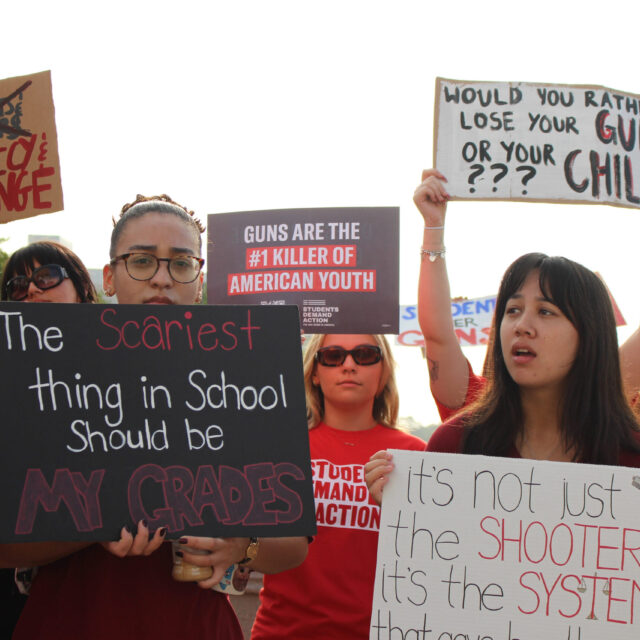Stop Arming Teachers Toolkit
Preface
Arming teachers does not make our schools safer. Decades of study of school shooting incidents and law enforcement responses tell us that an armed teacher cannot, in a moment of extreme duress and confusion, be expected to transform into a specially trained law enforcement officer. These policies put the entire school community at risk and jeopardize the trusting environment that is essential for keeping schools safe. In the several states that allow various personnel/individuals to carry guns in schools*, we are taking action to oppose arming teachers at school boards nationwide. This toolkit will guide you through some key talking points on opposing arming teachers and taking action at the school board level.
*You can find out if your state allows teachers or the general public to carry guns in K-12 schools here.
What Does Arming Teachers Mean?
In several states, individuals, such as school personnel, are allowed to have a gun in the classroom and on school grounds due to misguided thinking that keeping a gun in the classroom will bolster school safety. Following the tragedy of school shootings, legislators can rashly discern that the answer to improving school safety is arming teachers or other school personnel. However, oftentimes the final decision for allowing arming teachers on school grounds falls to school boards, giving students, parents, teachers, and other school community stakeholders a chance to sway the implementation of this perilous policy.
Why is Arming Teachers Harmful?
Arming teachers can introduce new risks to the classroom and places excess stress on educators to be the responder in high pressure situations. The research below accentuates these risks and can be utilized to underscore to others the importance of opposing arming teachers.
The Research
- In a 2022 survey of nearly 1,000 US teachers, 54 percent expressed the belief that allowing teachers to carry firearms for school security would decrease overall safety.
- 76 percent of surveyed pre-K–12 educators oppose arming teachers and staff in public schools.
- An analysis of over five decades of active shooter incidents in K–12 schools found that in three in four of these incidents, the shooter or shooters were school-age and were current or former students.
- High school students with lower levels of school connectedness, which is related to positive relationships with teachers, are more likely to engage in violence with a weapon on school property.
What to Say When Talking About Arming Teachers
For a holistic overview of Everytown’s research on arming teachers, you can view our fact sheet on the risks of arming teachers.
Topline Supporting Points
- Teachers cannot and should not be expected to perform the job of a trained law enforcement officer
- In states that have laws aimed at arming school personnel, school staff receive significantly less training. In some of these states, no minimum training is required for armed school staff whatsoever.
- Even the most highly trained law enforcement officers in the country see their ability to shoot accurately decrease significantly in an active shooter situation.
- Asking teachers to potentially take the life of a current or former student is unrealistic
- Researchers found that in the six mass school shootings and 39 attempted mass school shootings in the two decades between 1999 and 2019, more than 9 in 10 shooters were current or former students at the school.
- Expecting teachers to take the life of a current or former student in such circumstances is both unrealistic and dangerous.
- Arming teachers jeopardizes trusting school environments, which are essential for ensuring school safety
- School hardening tactics—including costly technology that creates a fortress-like environment and repeated drills—chip away at the nurturing, trusting climate students need both for productive learning and for students’ willingness to ask an adult for help and to report destructive thoughts and behaviors. Armed teachers further undermine this emotionally safe school climate.
- Arming teachers introduces new liability risks
- School policies may expose teachers to criminal liability in the event policies are not consistent with state law. It is also unlikely that insurance companies would indemnify schools from monetary claims in these cases.
- State immunity laws cannot exempt schools from all legal liability, particularly federal civil rights liability.
- The multiple incidents of guns from armed staff being misplaced, fired inadvertently, or stolen from teachers remind us of the daily risk of bringing more guns into schools.
- There have been several incidents of guns unintentionally or intentionally discharged on school grounds by school staff, including those approved to carry firearms on school grounds.
Alternatives to Arming Teachers
- Protect Schools with Evidence Based Actions
- Establishing safe and equitable schools
- Establishing crisis intervention programs
- Ensuring sufficient mental health counselors
- Informing parents about secure gun storage
- Implementing basic security upgrades
- Planning in advance for emergencies
- Enacting Sensible Gun Laws
- Extreme Risk Laws
- Secure firearm storage laws
- Laws requiring background checks on all gun sales
- Laws raising the age to purchase semiautomatic firearms to 21
- Laws prohibiting assault weapons and high-capacity magazines
Writing Your School Board Resolution
Are you ready to go to your school board? Use the tactics and tips in Students Demand Action’s Urge Your School Board to Act on School Safety Toolkit to guide your advocacy efforts. You can find a model Arming Teachers school board resolution here, that can be edited to your specific state. Students in states, such as Ohio, have also combined this resolution with a secure storage resolution, an example can be found here, to address the entire landscape of school safety in their state. Make sure to send your model school board resolution to students@everytown.org prior to going to your school board so the Students Demand Action team can review it.


